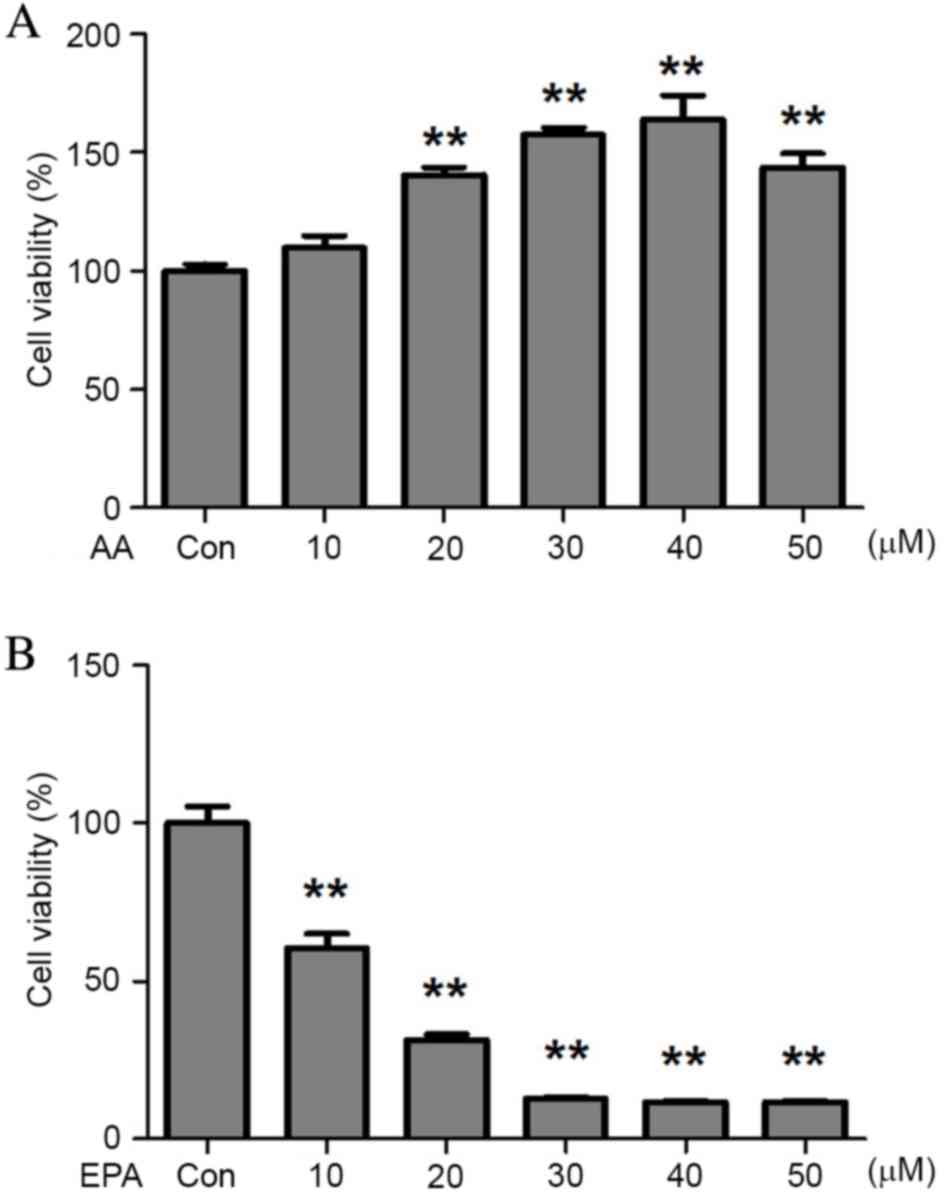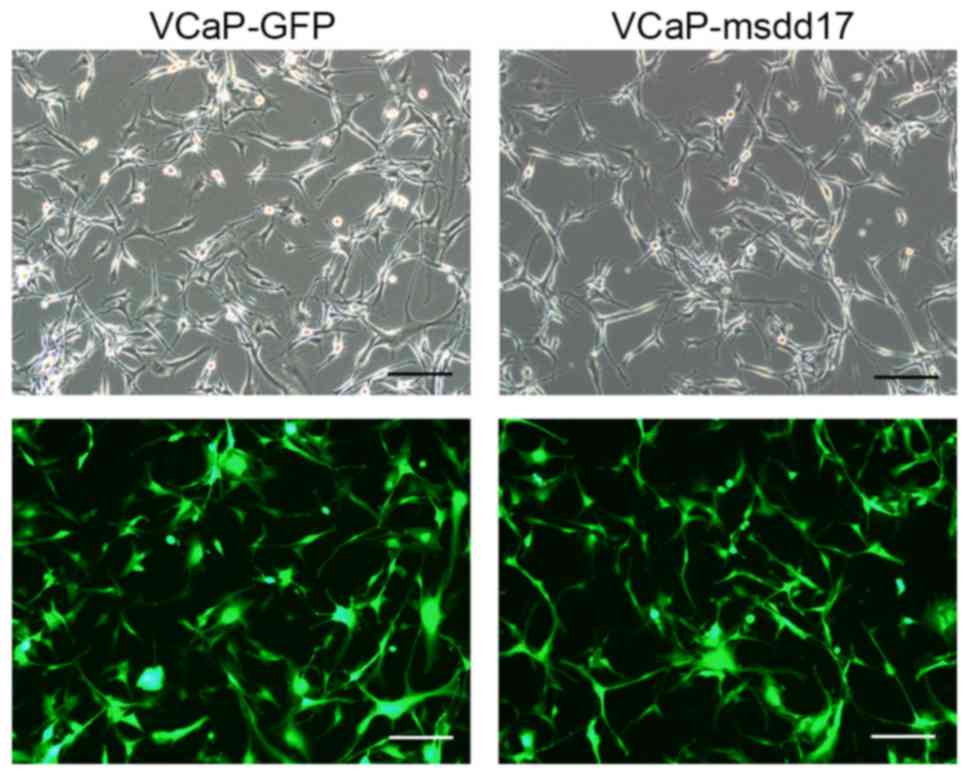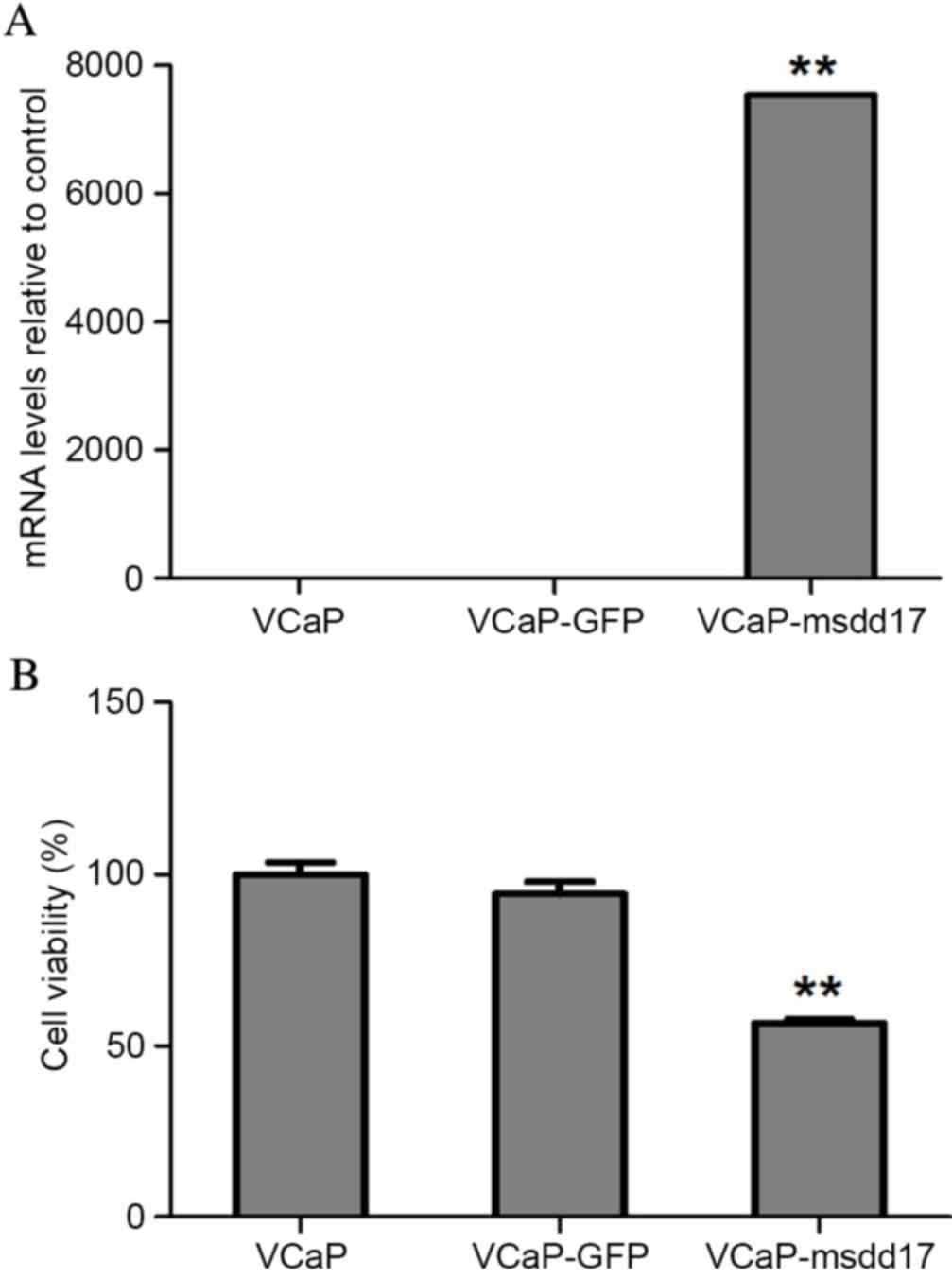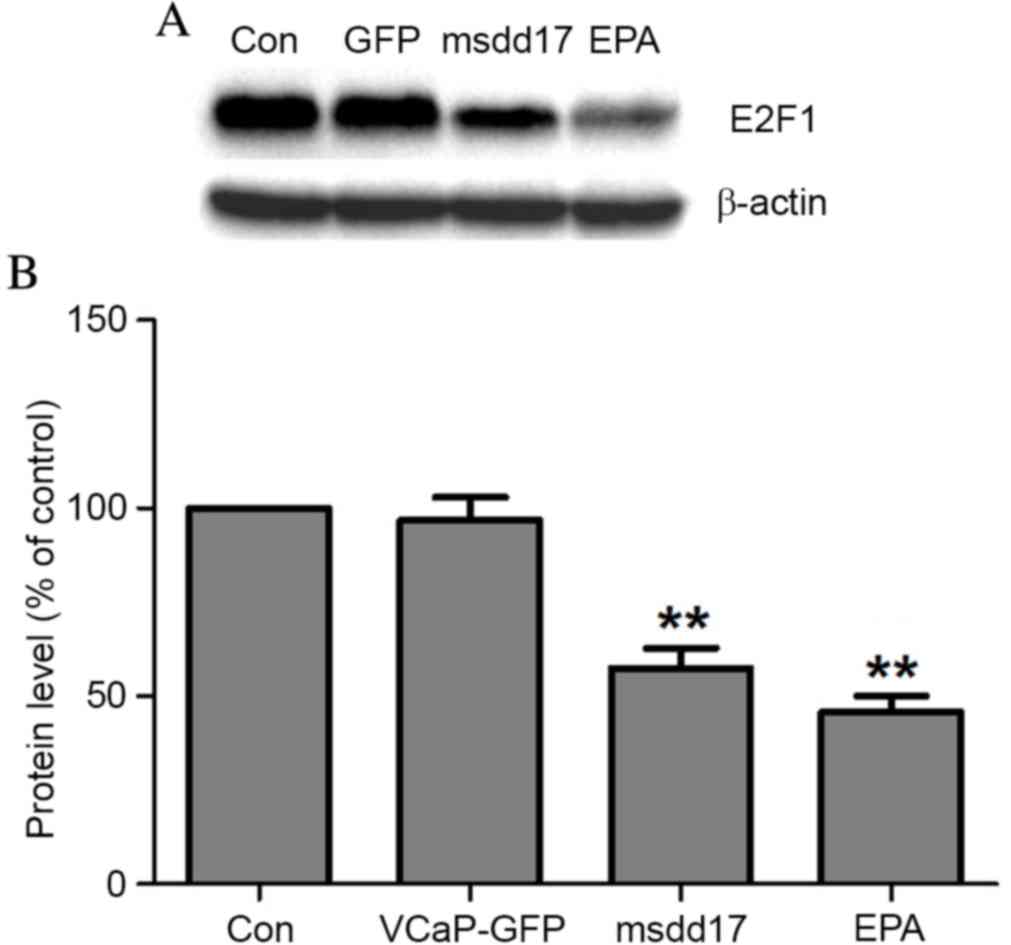An Ω-3 fatty acid desaturase-expressing gene attenuates prostate cancer proliferation by cell cycle regulation
- Authors:
- Published online on: March 21, 2017 https://doi.org/10.3892/ol.2017.5880
- Pages: 3717-3721
Abstract
Introduction
Prostate cancer is the fourth leading cause of cancer-associated mortality and the second most prevalent cancer worldwide (1). In developed countries, prostate cancer is the most commonly diagnosed cancer in men and affects >17% of men worldwide (1). In the US, prostate cancer is the most common malignancy and the second leading cause of cancer-associated mortality (2). Globally, a high incidence of prostate cancer is associated with excessive consumption of Ω-6 polyunsaturated fatty acids (PUFAs), commonly found in red and organ meats, refined vegetable oils and cooked processed meat (3–5). Conversely, evidence suggests that an Ω-3 PUFA-rich diet is inversely associated with prostate cancer development (6–9).
Both Ω-6 and Ω-3 PUFAs are essential fatty acids (10), and while Ω-3 PUFAs have protective effects, Ω-6 PUFAs may serve a role in cancer development (11–14). It has been demonstrated that dietary intake of long-chain Ω-3 PUFAs reduces the incidence of several types of cancer and alleviates cancer-associated complications (15,16). Clinically, long-term intake of dietary or supplemental docosahexaenoic acid (DHA) and eicosapentaenoic acid (EPA) (both Ω-3 PUFAs) is associated with a decreased risk of prostate cancer development (6–9), increased sensitivity to chemotherapy treatment (14) and decreased risk of advanced stage disease, metastases and cancer-associated mortality (8,17,18). Additionally, dietary Ω-3 PUFAs enhance hormone ablation therapy in androgen-dependent prostate cancer (19) and attenuate prostate cancer growth in primary prostate cancer development (20) and xenograft models (19). Therefore, Ω-3 PUFAs may be important in the prevention and treatment of prostate cancer.
The EPA-rich Saprolegnia diclina gene, sdd17, encodes an Ω-3 fatty acid desaturase that converts exogenous arachidonic acid (AA), an Ω-6 PUFA, into EPA (21). It has been reported that sdd17 from EPA-rich fungus is expressed at high levels and increases Ω-3 fatty acid concentrations in mammalian cells (22). In the present study, prostate cancer cells were infected with a lentivirus carrying the sdd17 gene and the underlying mechanisms of Ω-3 PUFAs on prostate cell proliferation were evaluated. The potential positive outcomes of the present study may benefit patients with prostate cancer.
Materials and methods
Reagents
All cell culture reagents were purchased from Incoterm Fisher Scientific, Inc. (Waltham, MA, USA). AA, EPA, propidium iodide (PI) and PUFA standards were obtained from Sigma-Aldrich; Merck Millipore (Darmstadt, Germany). Water-soluble tetrazolium (WST) was acquired from Dojindo Molecular Technologies, Inc. (Kumamoto, Japan). Anti-E2F transcription factor 1 antibodies (#sc-251; dilution, 1:1,000) were obtained from Santa Cruz Biotechnology, Inc. (Dallas, TX, USA) and anti-β-actin antibodies (#ab8226; dilution, 1:2,000) were purchased from Abcam (Cambridge, UK).
Cell culture and proliferation assays
The human prostate cancer cell line VCaP was obtained from the American Type Culture Collection (Manassas, VA, USA). VCaP cells were cultured at 37°C and 5% CO2 in Dulbecco's modified Eagle's medium supplemented with 10% fetal bovine serum (Invitrogen; Thermo Fisher Scientific, Inc.), 100 IU/ml penicillin and 100 µg/ml streptomycin. Cell proliferation assays were performed in 96-well plates. Cells (5×103 per well) were incubated for 24 h with different concentrations of PUFAs (10–50 µM), stained with WST at 37°C for 1 h and quantified at 450 nm (ELX800; BioTek Instruments, Inc., Winooski, VT, USA).
Overexpression of msdd17 by lentiviral transfection
The sdd17 gene was cloned from S. diclina based on its nucleotide sequence (GenBank accession no. AY373823). The codons of sdd17 cDNA were optimized for efficient translation in mammalian cells, resulting in the msdd17 gene. The msdd17 cDNA was subsequently inserted into the PLJM1 lentivirus vector (Addgene, Inc., Cambridge, MA, USA); pMD2.G and psPAX2 plasmids were co-transfected with PLJM1-msdd17 (vehicle plasmid) into 293T cells (American Type Culture Collection, Manassas, VA, USA) using X-tremeGENE™ HP DNA transfection reagent (Roche Diagnostics, Indianapolis, IN, USA). In order to generate a stable msdd17-overexpressing cell line, lentivirus-containing supernatant was harvested 48 h post-transfection and used to infect VCaP cells.
Reverse transcription-quantitative polymerase chain reaction (RT-qPCR) analysis of msdd17 gene expression levels
Total RNA was extracted using TRIzol® reagent, and was subsequently treated with DNase I and reverse transcribed using the PrimeScript™ RT reagent kit (Takara Bio, Inc., Shiga, Japan) following the manufacturer protocol. qPCR was performed using an Applied Biosystems StepOnePlus™ Real-Time PCR system (Applied Biosystems; Thermo Fisher Scientific, Inc.). FastStart Universal SYBR Green Master (Rox) was obtained from Roche Diagnostics (#04913914001). The qPCR conditions consisted of 1 cycle at 50°C for 2 min, followed by 1 cycle at 95°C for 30 sec, and 40 cycles at 95°C for 15 sec, 58°C for 30 sec and 72°C for 30 sec. The experiments were repeated six times. The results were normalized according to the expression levels of β-actin RNA. Results were expressed using the 2−ΔΔCq method (23). The primer sequences were as follows: msdd17, forward, 5′-GTACACAAACCAAGCTCCGC-3′ and reverse, 5′-CCATCCTGACCCCATTCGAG-3′; and β-actin, forward, 5′-GCTCTGGCTCCTAGCACCAT-3′ and reverse, 5′-GGGCCGGACTCATCGTACT-3′.
Gas chromatography (GC) analysis
Lipid extraction from VCaP cells was performed following a previously described protocol (24). Gas chromatography was performed on an Agilent 7890A Gas Chromatograph (Agilent Technologies, Inc., Santa Clara, CA, USA). Compounds were identified by comparing their retention times with those of PUFA standards.
Cell cycle analysis
Following incubation overnight in Dulbecco's modified Eagle's medium (Invitrogen), VCaP cells were harvested and rinsed with PBS twice. Prior to cell cycle analysis, cells were fixed in 70% pre-cold ethanol at 4°C overnight, and prior to flow cytometry, cells were washed twice with PBS and then resuspended with PBS containing 10 mg/ml PI (Sigma-Aldrich; Merck Millipore) and incubated for 15 min in the dark at room temperature. DNA content was analyzed using a BD FACStar flow cytometer and the percentages of different cell cycle phases were determined using a ModFit LT software version 4.0 (BD Biosciences, San Jose, CA, USA).
Western blotting
VCaP cells were treated with PUFA agents at 37°C for various times as indicated in the experiments. The cells were collected into lysis buffer [50 mM Tris-HCl (pH 8.0), 150 mM NaCl, 0.5% sodium deoxycholate, 1% Nonidet P-40, 0.1% SDS, 100 g/ml PMSF and aprotinin] and placed on ice for 30 min. Cell lysates were sonicated on ice for at least 30 sec and then cleared by centrifugation at 12,000 × g for 30 min at 4°C. Equal amounts of total protein (40 µg) were separated by SDS-PAGE and transferred onto a nitrocellulose membrane. The membranes were probed with the appropriate antibodies at 4°C overnight with gentle agitation. Immunoreactivity was detected by ECL and quantified using ImageLab version 4.0 analysis software (Bio-Rad Laboratories, Inc., Hercules, CA, USA).
Statistical analysis
Data are presented as the mean ± standard error of at least three independent experiments. All statistical analyses were performed using GraphPad Prism version 5.01 (GraphPad Software, Inc., La Jolla, CA, USA) and included either two-tailed Student's t-test or one-way analysis of variance followed by Dunnett's test for comparing the means of two or multiple groups, respectively. P<0.05 was considered to indicate a statistically significant difference.
Results
Effect of Ω-3 PUFAs on VCaP cell growth
To assess the effects of Ω-3 PUFAs on prostate cancer cells, VCaP cells were exposed to either AA or EPA. The results demonstrated that AA stimulated VCaP cell proliferation (Fig. 1A), which was consistent with previous observations in breast (24) and endometrial (25,26) cancer cell lines. Conversely, EPA effectively inhibited prostate cancer cell growth in vitro. At the highest concentration (50 µM), EPA caused an 8-fold reduction in VCaP cell viability (Fig. 1B), demonstrating that it inhibited VCaP cell viability in a dose-dependent manner.
Effect of msdd17 on VCaP cell growth
To assess the effect of msdd17 on prostate cancer cells, VCaP cells were infected with a lentivirus carrying the msdd17 gene (VCaP-msdd17 cells). A green fluorescent protein (GFP)-expressing line, VCaP-GFP, was generated as a control.
The lentivirus carrying the msdd17 gene was used to infect VCaP cells and the co-expression of GFP allowed the identification of the cells that expressed the msdd17 gene. Following infection with the lentivirus, the VCaP cells exhibited bright fluorescence indicating a high expression level of the transgene (Fig. 2). qPCR was performed to analyze msdd17 gene expression levels. The results indicated significantly increased msdd17 expression levels in the VCaP-msdd17 cells compared with those of the control cells (Fig. 3A), demonstrating that the msdd17 gene may be highly expressed in transfected VCaP cells, which lack the gene naturally.
Msdd17 gene transfection resulted in the conversion of Ω-6 PUFAs into Ω-3 PUFAs in the VCaP cells (Table I). GC analyses demonstrated that 26% of AA was converted into EPA (Table I). Consistent with this observation, msdd17 gene expression significantly suppressed VCaP cell viability (Fig. 3B). Taken together, these results indicated that endogenous EPA, mediated by msdd17 gene expression, directly inhibited prostate cancer cell growth.
Effect of msdd17 on VCaP cell cycle
Flow cytometry analyses demonstrated that msdd17 gene expression resulted in G2 arrest in the cell cycle of VCaP cells (Table II). To assess the mechanism by which Ω-3 PUFAs suppress cell proliferation through cell cycle arrest, the expression of E2F1 was evaluated following EPA treatment. Western blot analysis demonstrated that EPA treatment significantly decreased E2F1 expression and that the expression of msdd17 mimicked the effect of EPA on E2F1 regulation (Fig. 4).
Discussion
It is well known that Ω-3 PUFAs have tumor-suppressing effects. The msdd17 gene, which encodes an Ω-3 fatty acid desaturase, converts AA into EPA (21,22). However, little is known regarding the function of the msdd17 gene in tumor cells in vitro. Therefore, the present study aimed to investigate the effect and underlying mechanisms of the msdd17 gene on prostate cancer. The msdd17 gene was transfected directly into VCaP cells and the inhibitory effects of the gene on prostate cancer cell proliferation was confirmed. Further experiments demonstrated that msdd17 gene expression induced G2 cell cycle arrest in prostate cancer cells and that E2F1 may be associated with this process. To the best of our knowledge, these results demonstrate, for the first time, that msdd17 gene transfection into prostate cancer cells may be used as a novel therapeutic strategy to treat prostate cancer.
Mounting evidence has linked the dietary consumption of Ω-3 PUFAs with the prevention or attenuation of several types of cancer, including breast (27), endometrial (28) and prostate (6–9) cancer. In the present study, VCaP cells were exposed to either AA or EPA, and it was demonstrated that while EPA inhibited prostate cancer cell proliferation in a dose-dependent manner, AA stimulated cell proliferation. GC analyses indicated an association between msdd17 gene expression and the successful conversion of AA into EPA. Additionally, cell proliferation assays demonstrated that msdd17 gene expression inhibited the proliferation of prostate cancer cells. Therefore, expression of the msdd17 gene may suppress tumorigenesis by simultaneously increasing endogenous EPA levels and decreasing endogenous AA levels.
E2F1 is a transcription factor involved in the pRb/E2F1 pathway and in cell cycle regulation (29), and it enhances glycolysis by suppressing Sirt6 transcription in prostate cancer cells (30). Previous studies have reported that G2/M cell cycle arrest is associated with the downregulation of E2F1 (31–33). In the present study, cell cycle analyses indicated that EPA and msdd17 gene expression inhibited prostate cancer cell proliferation by inducing prostate cancer G2 cell cycle arrest. As E2F1 serves a critical role in cellular proliferation, differentiation and apoptosis (34,35), the present study investigated whether E2F1 was involved in msdd17 gene expression-induced cell proliferation arrest in prostate cancer cells. The results demonstrated that msdd17 gene expression and exogenous EPA treatment significantly decreased E2F1 expression.
In conclusion, to the best of our knowledge, the present study is the first to evaluate the function of the msdd17 gene in tumor cells in vitro. The msdd17 gene inhibited prostate cancer cell proliferation by regulating the prostate cancer cell cycle. Therefore, stimulating the conversion of AA into EPA may be an effective therapeutic approach to treat prostate cancer.
Acknowledgements
The present study was supported by grants from the National Basic Research Program of China (973 Program; grant no. 2013CB945202), the National Natural Science Foundation of China (grant nos. 81630021 and 81170780 to A.Z., 81372798 to F.L. and 81200570 to L.X.), the Ph.D. Programs Foundation of Ministry of Education of China (grant no. 20113234110005), the Scientific Support Program of Jiangsu Province (grant no. BE2012756), the Natural Science Foundation of Jiangsu Province of China (grant nos. BK20130059 and 2011766), the Natural Science Foundation of Nanjing Medical University (grant no. 2016NJMUZD027 to J.P.), the Young Medical Talents of Jiangsu Province (grant no. QNRC2016663 to J.P.), and the High-level Innovative Talents Reward from Jiangsu Province (to F.L.).
References
|
Torre LA, Bray F, Siegel RL, Ferlay J, Lortet-Tieulent J and Jemal A: Global cancer statistics, 2012. CA Cancer J Clin. 65:87–108. 2015. View Article : Google Scholar : PubMed/NCBI | |
|
Siegel RL, Miller KD and Jemal A: Cancer statistics, 2015. CA Cancer J Clin. 65:5–29. 2015. View Article : Google Scholar : PubMed/NCBI | |
|
Apte SA, Cavazos DA, Whelan KA and Degraffenried LA: A low dietary ratio of omega-6 to omega-3 Fatty acids may delay progression of prostate cancer. Nutr Cancer. 65:556–562. 2013. View Article : Google Scholar : PubMed/NCBI | |
|
Rodriguez C, McCullough ML, Mondul AM, Jacobs EJ, Chao A, Patel AV, Thun MJ and Calle EE: Meat consumption among Black and White men and risk of prostate cancer in the cancer prevention study II nutrition cohort. Cancer Epidemiol Biomarkers Prev. 15:211–216. 2006. View Article : Google Scholar : PubMed/NCBI | |
|
Walker M, Aronson KJ, King W, Wilson JW, Fan W, Heaton JP, MacNeily A, Nickel JC and Morales A: Dietary patterns and risk of prostate cancer in Ontario, Canada. Int J Cancer. 116:592–598. 2005. View Article : Google Scholar : PubMed/NCBI | |
|
Hedelin M, Chang ET, Wiklund F, Bellocco R, Klint A, Adolfsson J, Shahedi K, Xu J, Adami HO, Grönberg H and Bälter KA: Association of frequent consumption of fatty fish with prostate cancer risk is modified by COX-2 polymorphism. Int J Cancer. 120:398–405. 2007. View Article : Google Scholar : PubMed/NCBI | |
|
Norrish AE, Skeaff CM, Arribas GL, Sharpe SJ and Jackson RT: Prostate cancer risk and consumption of fish oils: A dietary biomarker-based case-control study. Br J Cancer. 81:1238–1242. 1999. View Article : Google Scholar : PubMed/NCBI | |
|
Leitzmann MF, Stampfer MJ, Michaud DS, Augustsson K, Colditz GC, Willett WC and Giovannucci EL: Dietary intake of n-3 and n-6 fatty acids and the risk of prostate cancer. Am J Clin Nutr. 80:204–216. 2004.PubMed/NCBI | |
|
Pham TM, Fujino Y, Kubo T, Ide R, Tokui N, Mizoue T, Ogimoto I, Matsuda S and Yoshimura T: Fish intake and the risk of fatal prostate cancer: Findings from a cohort study in Japan. Public Health Nutr. 12:609–613. 2009. View Article : Google Scholar : PubMed/NCBI | |
|
Simopoulos AP: The importance of the omega-6/omega-3 fatty acid ratio in cardiovascular disease and other chronic diseases. Exp Biol Med (Maywood). 233:674–688. 2008. View Article : Google Scholar : PubMed/NCBI | |
|
de Lorgeril M and Salen P: New insights into the health effects of dietary saturated and omega-6 and omega-3 polyunsaturated fatty acids. BMC Med. 10:502012. View Article : Google Scholar : PubMed/NCBI | |
|
Berquin IM, Edwards IJ and Chen YQ: Multi-targeted therapy of cancer by omega-3 fatty acids. Cancer Lett. 269:363–377. 2008. View Article : Google Scholar : PubMed/NCBI | |
|
Patel MI, Kurek C and Dong Q: The arachidonic acid pathway and its role in prostate cancer development and progression. J Urol. 179:1668–1675. 2008. View Article : Google Scholar : PubMed/NCBI | |
|
Hajjaji N and Bougnoux P: Selective sensitization of tumors to chemotherapy by marine-derived lipids: A review. Cancer Treat Rev. 39:473–488. 2013. View Article : Google Scholar : PubMed/NCBI | |
|
Larsson SC, Kumlin M, Ingelman-Sundberg M and Wolk A: Dietary long-chain n-3 fatty acids for the prevention of cancer: A review of potential mechanisms. Am J Clin Nutr. 79:935–945. 2004.PubMed/NCBI | |
|
Azrad M, Turgeon C and Demark-Wahnefried W: Current evidence linking polyunsaturated Fatty acids with cancer risk and progression. Front Oncol. 3:2242013. View Article : Google Scholar : PubMed/NCBI | |
|
Fradet V, Cheng I, Casey G and Witte JS: Dietary omega-3 fatty acids, cyclooxygenase-2 genetic variation, and aggressive prostate cancer risk. Clin Cancer Res. 15:2559–2566. 2009. View Article : Google Scholar : PubMed/NCBI | |
|
Pelser C, Mondul AM, Hollenbeck AR and Park Y: Dietary fat, fatty acids, and risk of prostate cancer in the NIH-AARP diet and health study. Cancer Epidemiol Biomarkers Prev. 22:697–707. 2013. View Article : Google Scholar : PubMed/NCBI | |
|
McEntee MF, Ziegler C, Reel D, Tomer K, Shoieb A, Ray M, Li X, Neilsen N, Lih FB, O'Rourke D and Whelan J: Dietary n-3 polyunsaturated fatty acids enhance hormone ablation therapy in androgen-dependent prostate cancer. Am J Pathol. 173:229–241. 2008. View Article : Google Scholar : PubMed/NCBI | |
|
Berquin IM, Min Y, Wu R, Wu J, Perry D, Cline JM, Thomas MJ, Thornburg T, Kulik G, Smith A, et al: Modulation of prostate cancer genetic risk by omega-3 and omega-6 fatty acids. J Clin Invest. 117:1866–1875. 2007. View Article : Google Scholar : PubMed/NCBI | |
|
Pereira SL, Huang YS, Bobik EG, Kinney AJ, Stecca KL, Packer JC and Mukerji P: A novel omega3-fatty acid desaturase involved in the biosynthesis of eicosapentaenoic acid. Biochem J. 378:665–671. 2004. View Article : Google Scholar : PubMed/NCBI | |
|
Chen Y, Zhang M and Gou K: SDD17 desaturase can convert arachidonic acid to eicosapentaenoic acid in mammalian cells. Biochem Biophys Res Commun. 394:158–162. 2010. View Article : Google Scholar : PubMed/NCBI | |
|
Livak KJ and Schmittgen TD: Analysis of relative gene expression data using real-time quantitative PCR and the 2(−Delta Delta C(T)) Method. Methods. 25:402–408. 2001. View Article : Google Scholar : PubMed/NCBI | |
|
Chen Z, Zhang Y, Jia C, Wang Y, Lai P, Zhou X, Song Q, Lin J, Ren Z, Gao Q, et al: mTORC1/2 targeted by n-3 polyunsaturated fatty acids in the prevention of mammary tumorigenesis and tumor progression. Oncogene. 33:4548–4557. 2014. View Article : Google Scholar : PubMed/NCBI | |
|
Pan J, Cheng L, Bi X, Zhang X, Liu S, Bai X, Li F and Zhao AZ: Elevation of ω-3 polyunsaturated fatty acids attenuates PTEN-deficiency induced endometrial cancer development through regulation of COX-2 and PGE2 Production. Sci Rep. 5:149582015. View Article : Google Scholar : PubMed/NCBI | |
|
Zheng H, Tang H, Liu M, He M, Lai P, Dong H, Lin J, Jia C, Zhong M, Dai Y, et al: Inhibition of endometrial cancer by n-3 polyunsaturated fatty acids in preclinical models. Cancer Prev Res (Phila). 7:824–834. 2014. View Article : Google Scholar : PubMed/NCBI | |
|
Gago-Dominguez M, Yuan JM, Sun CL, Lee HP and Yu MC: Opposing effects of dietary n-3 and n-6 fatty acids on mammary carcinogenesis: The Singapore Chinese Health Study. Br J Cancer. 89:1686–1692. 2003. View Article : Google Scholar : PubMed/NCBI | |
|
Arem H, Neuhouser ML, Irwin ML, Cartmel B, Lu L, Risch H, Mayne ST and Yu H: Omega-3 and omega-6 fatty acid intakes and endometrial cancer risk in a population-based case-control study. Eur J Nutr. 52:1251–1260. 2013. View Article : Google Scholar : PubMed/NCBI | |
|
Chen HZ, Tsai SY and Leone G: Emerging roles of E2Fs in cancer: An exit from cell cycle control. Nat Rev Cancer. 9:785–797. 2009. View Article : Google Scholar : PubMed/NCBI | |
|
Wu M, Seto E and Zhang J: E2F1 enhances glycolysis through suppressing Sirt6 transcription in cancer cells. Oncotarget. 6:11252–11263. 2015. View Article : Google Scholar : PubMed/NCBI | |
|
Maudet C, Mano M, Sunkavalli U, Sharan M, Giacca M, Förstner KU and Eulalio A: Functional high-throughput screening identifies the miR-15 microRNA family as cellular restriction factors for Salmonella infection. Nat Commun. 5:47182014. View Article : Google Scholar : PubMed/NCBI | |
|
Jaganathan A, Chaurasia P, Xiao GQ, Philizaire M, Lv X, Yao S, Burnstein KL, Liu DP, Levine AC and Mujtaba S: Coactivator MYST1 regulates nuclear factor-κB and androgen receptor functions during proliferation of prostate cancer cells. Mol Endocrinol. 28:872–885. 2014. View Article : Google Scholar : PubMed/NCBI | |
|
Wang S, Li W, Xue Z, Lu Y, Narsinh K, Fan W, Li X, Bu Q, Wang F, Liang J, et al: Molecular imaging of p53 signal pathway in lung cancer cell cycle arrest induced by cisplatin. Mol Carcinog. 52:900–907. 2013. View Article : Google Scholar : PubMed/NCBI | |
|
Lee KY, Lee JW, Nam HJ, Shim JH, Song Y and Kang KW: PI3-kinase/p38 kinase-dependent E2F1 activation is critical for Pin1 induction in tamoxifen-resistant breast cancer cells. Mol Cells. 32:107–111. 2011. View Article : Google Scholar : PubMed/NCBI | |
|
Gomez-Gutierrez JG, Garcia-Garcia A, Hao H, Rao XM, de Montes Oca-Luna R, Zhou HS and McMasters KM: Adenovirus-mediated expression of truncated E2F-1 suppresses tumor growth in vitro and in vivo. Cancer. 116:4420–4423. 2010. View Article : Google Scholar : PubMed/NCBI |













